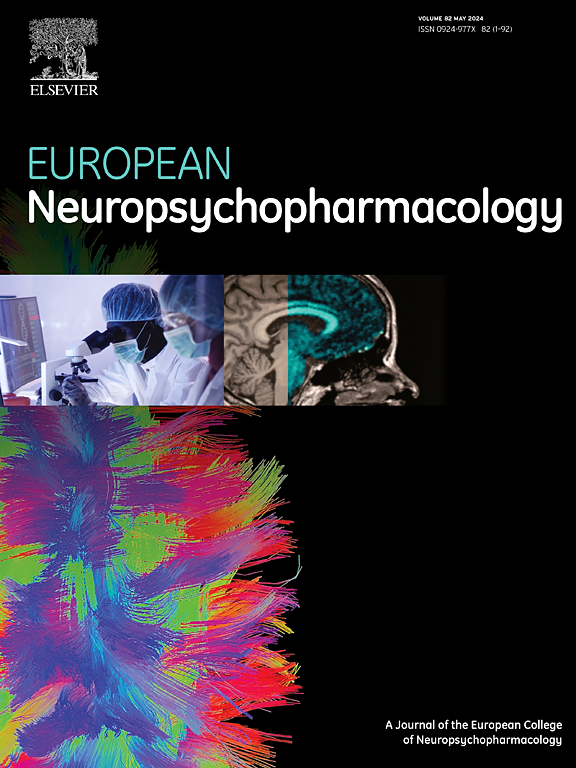Lack of transparency on baseline pharmacological treatments in Clinical High-Risk for psychosis (CHR-P) may degrade precision: A systematic review and meta-analysis
IF 6.7
2区 医学
Q1 CLINICAL NEUROLOGY
引用次数: 0
Abstract
The field of Clinical High-Risk for Psychosis (CHR-P) is a dynamic area within contemporary psychiatry and serves as a crucial testing ground for precision prognostic models. Nonetheless, some foundational aspects remain inadequately conceptualized and consequently not transparently reported, such as baseline pharmacotherapy. A systematic review and meta-analysis were conducted by searching the MEDLINE and Cochrane Library databases for studies published up to August 31, 2024. Eligible studies included CHR-P samples, reported numeric data on outcomes at follow-up, and examined the transition to psychosis as an outcome. Data extraction adhered to PRISMA guidelines, focusing on baseline pharmacological exposure to antipsychotics, antidepressants, benzodiazepines, and mood stabilizers. A total of 95 studies were analyzed. The majority of studies (96.8 %) explicitly stated whether baseline exposure to antipsychotics was allowed as part of the inclusion criteria. However, actual baseline exposure to antipsychotics was quantified in only 60 % of these studies. Exposure to non-antipsychotic psychoactive therapies was reported in only a fraction of the studies (36.8 % for antidepressants, 16.8 % for benzodiazepines, and 14.7 % for mood stabilizers). In CHR-P longitudinal studies, the meta-analytic proportions of self-disclosed baseline pharmacological exposure ranged from 23.5 % to 24.5 % for antipsychotics, 28.5 % to 30.6 % for antidepressants, 11.2 % to 14.6 % for benzodiazepines, and 5.6 % to 5.9 % for mood stabilizers.
Overall, a non negligible fraction of CHR-P participants is already under psychoactive pharmacological treatment at enrollment. The lack of consistent transparency in this respect may limit the effectiveness of prognostic models. Improved reporting practices are necessary to enhance precision in preventive psychiatry.
临床高危精神病(chrp)基线药物治疗缺乏透明度可能降低准确性:一项系统回顾和荟萃分析
临床高危精神病(chrp)领域是当代精神病学的一个动态领域,是精确预后模型的关键试验场。尽管如此,一些基础方面仍然没有充分的概念化,因此没有透明的报告,例如基线药物治疗。通过检索MEDLINE和Cochrane图书馆数据库,对截至2024年8月31日发表的研究进行系统评价和荟萃分析。符合条件的研究包括chrp样本,报告了随访结果的数字数据,并检查了向精神病的转变。数据提取遵循PRISMA指南,重点关注抗精神病药、抗抑郁药、苯二氮卓类药物和情绪稳定剂的基线药理学暴露。共分析了95项研究。大多数研究(96.8%)明确说明是否允许基线接触抗精神病药物作为纳入标准的一部分。然而,这些研究中只有60%量化了抗精神病药物的实际基线暴露。只有一小部分研究报告暴露于非抗精神病精神活性治疗(抗抑郁药36.8%,苯二氮卓类药物16.8%,情绪稳定剂14.7%)。在chrp纵向研究中,自我披露基线药物暴露的meta分析比例在抗精神病药物23.5%至24.5%之间,抗抑郁药物28.5%至30.6%之间,苯二氮卓类药物11.2%至14.6%之间,情绪稳定剂5.6%至5.9%之间。总的来说,不可忽略的一部分chrp参与者在入组时已经接受了精神药物治疗。在这方面缺乏一致的透明度可能会限制预测模型的有效性。为了提高预防精神病学的准确性,改进报告实践是必要的。
本文章由计算机程序翻译,如有差异,请以英文原文为准。
求助全文
约1分钟内获得全文
求助全文
来源期刊

European Neuropsychopharmacology
医学-精神病学
CiteScore
10.30
自引率
5.40%
发文量
730
审稿时长
41 days
期刊介绍:
European Neuropsychopharmacology is the official publication of the European College of Neuropsychopharmacology (ECNP). In accordance with the mission of the College, the journal focuses on clinical and basic science contributions that advance our understanding of brain function and human behaviour and enable translation into improved treatments and enhanced public health impact in psychiatry. Recent years have been characterized by exciting advances in basic knowledge and available experimental techniques in neuroscience and genomics. However, clinical translation of these findings has not been as rapid. The journal aims to narrow this gap by promoting findings that are expected to have a major impact on both our understanding of the biological bases of mental disorders and the development and improvement of treatments, ideally paving the way for prevention and recovery.
 求助内容:
求助内容: 应助结果提醒方式:
应助结果提醒方式:


